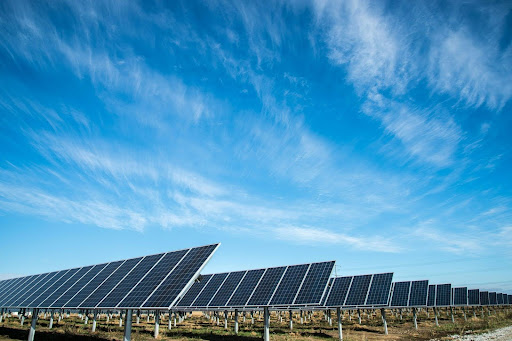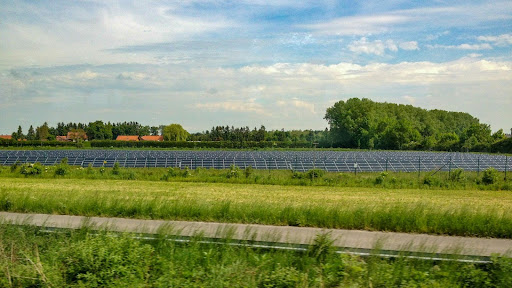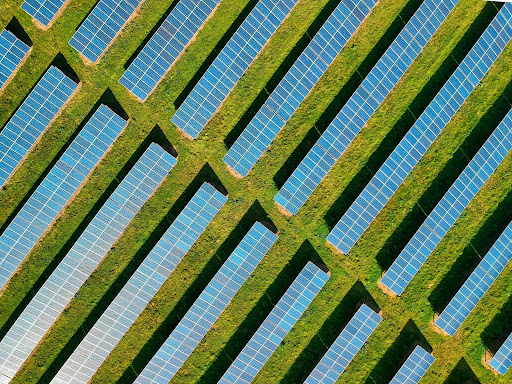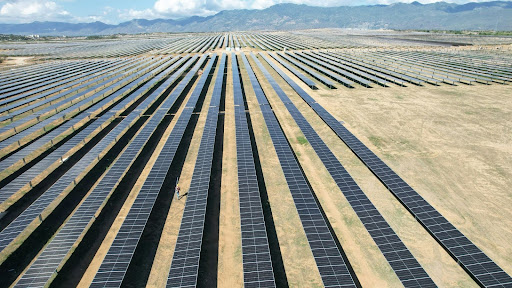Key Takeaways
- Big solar power systems are a key part of the green energy movement, providing important benefits for the environment.
- These systems need a lot of land, but they are a cheaper source of energy over the long term than fossil fuels.
- Some problems with these systems include storage of energy and inconsistent availability of sunlight.
- Government support and support from the community are very important for making large solar projects successful.
- Nuance Energy’s Osprey PowerRACK® offers quick installation, adaptability to tough terrains, and eliminates the need for geotechnical reports—making it an efficient, cost-effective choice for large-scale solar projects.
| Nuance Energy is your superior solution for Ground Mount solar. Our patented foundation technology Osprey PowerRACK® allows for rapid installation using only handheld tools, significantly reducing both time and costs compared to traditional racking systems. This cutting-edge technology works for residential and commercial installations, and Nuance Energy empowers solar installers to take back control of their installation schedules, control project COGS, gain market share, increase the speed of installation, and reduce the cost of labor. In contrast, a traditional ground mount is much more unpredictable, slower, and costly.
Find out how Nuance Energy can accelerate your solar projects with the Osprey PowerRACK® line, and boost your profitability. Contact us today to discuss our innovative ground-mount solutions. |

Solar farms provide numerous benefits, including clean energy production, reduced greenhouse gas emissions, and increased energy independence.
Large-Scale Solar Systems
Large-scale solar systems, which are often called solar farms, can provide enough power for whole communities and greatly reduce the amount of carbon dioxide that we release into the atmosphere.
Let’s look at why these big solar power installations are becoming more popular and how they can help us create a sustainable future.
The Pros of Big Solar Systems
Benefits to the Environment
Large scale solar systems are a powerful tool in the fight against climate change. They replace fossil fuels with renewable energy, cutting carbon dioxide emissions and other pollutants that are harmful to the environment. This shift to clean energy is essential for preserving the planet and ensuring a sustainable future for the generations to come.
Additionally, solar farms help to conserve natural resources. Unlike coal or natural gas, solar energy is plentiful and limitless – and by using this resource, we can decrease the need for environmentally harmful extraction processes that are linked to fossil fuels.

A properly planned solar farm can benefit the environment by conserving water, decreasing air pollution, promoting biodiversity, and mitigating the impact of climate change.
Value for Money
Despite the fact that the upfront cost of large-scale solar systems can be quite high, the savings in the long run are considerable – and as the price of solar panels and related technology has dropped significantly in the last ten years, solar farms are more accessible than ever before.
|
Comparing Costs |
Regular Energy | Solar Power |
|
Initial Cost |
Low |
High |
|
Long-term Expense |
High |
Low |
|
Impact on Environment |
High |
Low |
Pouring resources into large-scale solar systems can result in significant savings over the long haul, particularly as the cost of energy keeps climbing on an upward trajectory.
Securing Energy
Large-scale solar systems can help to provide a more stable and secure energy supply by diversifying the mix of energy. Solar farms help countries to achieve greater energy independence by reducing the dependence on imported fossil fuels.
Solar energy is also less likely to be affected by changes in price or political issues, so it’s a more dependable and consistent source of energy.
Employment Opportunities and Economic Development
These solar projects require a skilled labor force for installation, maintenance, and operation. This creates job opportunities in many different sectors, from engineering and construction to sales and marketing.
In addition to this, solar farms boost local economies by drawing in investment and creating tax revenue. Solar projects will usually result in infrastructure enhancements and heightened economic activity in nearby areas.

Solar farms can maximize space utilization by integrating solar energy production with agricultural activities.
Obstacles for Large-Scale Solar Systems
Need for Land and Space
It takes a lot of land to put up thousands of solar panels for large-scale solar systems. Sometimes, this can mean that land that could be used for farming or one that is a natural habitat gets used instead.
For example, we can smartly locate solar farms on land that isn’t very fertile or areas that aren’t fit for farming. This way, we can tap into the power of the sun without interfering with our food supply or disrupting the homes of animals.
The Issue of Intermittency and Storage
There is a natural intermittency with solar energy because it relies on the presence of sunlight. This means that solar farms can only generate electricity during the day when the sun is out. When it’s nighttime or there are clouds in the sky, the energy production drops significantly.
So, how do we solve this problem? The answer is energy storage solutions such as batteries. These systems keep the surplus energy created during the peak sunlight hours for use when solar power is unavailable. However, the price and efficiency of current storage technologies may prevent their use from becoming more common.
Steep Upfront Costs
Despite the falling price of solar technology, the upfront investment needed for large-scale solar systems is still significant. The costs include buying land, purchasing solar panels, and installing infrastructure. This steep initial cost can discourage potential investors and developers.
However, the potential long-term savings on energy bills and the positive impact on the environment make solar farms a good investment. Government incentives and subsidies can also help to reduce some of the initial costs, making solar projects more financially feasible.
Another interesting alternative is opting for newer technologies rather than traditional solar systems. Products like Nuance Energy’s Osprey PowerRACK® provide a more affordable option for solar farms as they have no need for concrete and heavy equipment. Additionally, earth anchor foundations for these systems also allow for quicker, simpler installations, reducing labor costs and minimizing delays. With fewer site visits, ease of scalability and faster project timelines, it is generally a more cost-effective option for solar farms.
Effects on Ecosystems and Wildlife
The construction and operation of these facilities can disrupt natural habitats, affect water resources, and change the landscape. Developers can lessen these effects by performing comprehensive environmental evaluations prior to starting a project.
Different Kinds of Large-Scale Solar Systems
Solar Farms
Solar farms, sometimes referred to as photovoltaic (PV) power stations or solar parks, harness the sun’s energy and convert it directly into electricity using solar panels. These systems are the most frequently used for large-scale solar installations because they are straightforward and can be easily expanded.
Solar power stations can be set up in a variety of environments, from deserts to cityscapes, making them a flexible choice for producing renewable energy. Plus, ongoing improvements in solar panel technology are constantly enhancing the efficiency and affordability of these systems.

Large-scale solar systems contribute to economic development by creating jobs, stimulating local economies, attracting investments, and reducing energy costs for consumers and businesses.
Concentrated Solar Power (CSP)
Concentrated Solar Power (CSP) systems are designed to concentrate sunlight onto a small area by using mirrors or lenses. The concentrated sunlight generates heat, which is then converted into electricity. CSP systems work best in regions with a lot of direct sunlight, like deserts.
A significant benefit of CSP systems is the capacity to incorporate thermal energy storage, which means they can generate electricity even when the sun isn’t shining. This characteristic helps tackle the intermittency issue that comes with solar energy.
Solar Farms on Water
Solar farms on water are a clever idea that involves putting solar panels on water bodies like reservoirs or lakes. This method saves land, helps cut down on water evaporation, and increases panel efficiency due to the water’s cooling effect.
Floating solar farms are becoming more popular all over the world, especially in areas where there is not a lot of land available. They provide a sustainable way to produce renewable energy without using up valuable land resources.
Overcoming Hurdles and Making More Of Potential Advantages
Advancements in Technology
Improvements in the efficiency of solar panels, energy storage, and integration into the grid are making solar energy more readily available and dependable.
For instance, the progress in cutting-edge battery technologies is boosting energy storage capacity and lowering costs, which is aiding in resolving the intermittency problem. Plus, intelligent grid technologies are facilitating the improved incorporation of solar power into present energy networks, thereby increasing the total system efficiency.
Government Policies and Incentives
Many governments globally have seen the need to shift to renewable energy sources and have put various measures in place to back solar projects. This includes providing tax credits, subsidies, and grants to help cover the initial costs of installing solar panels – check out what the US government currently has to offer at Funding Opportunities | Department of Energy
In addition, governments can set renewable energy goals or requirements that force utilities to get a certain percentage of their energy from renewable sources. These types of policies can make it more attractive to invest in large-scale solar projects.
Getting the Community Involved and Onboard
Community involvement is key to successfully implementing large-scale solar systems. When you involve the local community, you build support for the solar projects and can address any concerns or objections that might come up. Developers need to make sure they communicate openly and transparently throughout the planning and construction phases.
Developers can cultivate a sense of pride and ownership in the project by including community members in the decision-making process – a strategy that helps gain the support of the public and guarantees that the advantages of solar energy, such as job creation and infrastructure improvements, are distributed to the local community.
Why Choose Nuance Energy’s Osprey PowerRACK® System?
Nuance Energy’s Osprey PowerRACK® is a practical choice for large-scale solar projects and solar farms because of its streamlined installation process. Unlike traditional systems that require heavy machinery and concrete foundations, the Osprey PowerRACK® can be installed with simple hand-held tools. This reduces labor costs and speeds up installation, making it easier to meet tight project deadlines.
Another advantage is the system’s adaptability to different terrains. Whether it’s rocky, sandy, or uneven ground, the Osprey PowerRACK® uses a patented earth anchor foundation that works well in a variety of soil types. This versatility means fewer delays due to challenging site conditions, which is crucial for large-scale solar projects where efficiency is key.
Additionally, the system eliminates the need for detailed geotechnical reports, further cutting costs and reducing pre-construction delays. For solar farms looking to maximize efficiency and minimize both financial and environmental impact, Nuance Energy’s product provides a reliable and scalable solution.
Looking to choose a cost-effective solution for your project?
Talk to our team and get a quote.
Frequently Asked Questions
What does a large-scale solar system mean?
A large-scale solar system, sometimes referred to as a solar farm or solar park, is a big setup of solar panels that is intended to produce electricity at a commercial level. These systems are usually installed on the ground and can cover many acres, generating enough power to supply thousands of households or businesses.
What are the environmental benefits of large-scale solar systems?
Solar energy is a renewable source of energy, which means it is plentiful and can be sustained. In contrast to fossil fuels, which are limited and require environmentally harmful extraction methods, solar power captures the sun’s energy without exhausting natural resources.
In addition, solar farms can be strategically planned to lessen their influence on nearby ecosystems. By thoughtfully choosing locations and putting into place precautions to safeguard wildlife and habitats, developers can make certain that solar projects are environmentally considerate.
What are the biggest obstacles to setting up large-scale solar?
One of the biggest obstacles is the high initial investment cost. Although the costs of solar technology have fallen, the initial expenses for acquiring land, equipment, and installation can be substantial.
Additionally, these systems are not always reliable and require energy storage solutions such as batteries to store surplus energy for use when solar power is not an option.
What are some cost-effective options for large-scale solar systems?
Ground-mounted systems like Nuance Energy’s Osprey PowerRACK® provide a scalable, cost-effective solution for large-scale solar systems and solar farms. Designed for quick and easy installation without heavy machinery or concrete, they significantly reduce labor costs and installation time, while their adaptability to various soil conditions makes them suitable for unpredictable terrains.
Save Time & Money on Your Next Solar Project
Request a QuoteRECENT POSTS
- DPW Solar vs Nuance Energy Mounted Solar Options: Cost & Benefits
- Geotechnical Report Cost & Requirements For Solar Projects
- Are Solar Panels Worth It In Nevada? Costs & Options
- OSPREY PowerRack Ground Mount System Compatibility: Single- and Dual-Axis Trackers
- Rammed Earth Foundation For Solar Arrays: Cost, Pros & Cons
- Agrivoltaics Explained: Solar & Agriculture Combined
- Large Scale Solar Systems Options: Pros & Cons
- Best Solar Options For Farms & Agriculture: Cost, Pros & Cons
- Unirac vs MT Solar Mounted Options: Cost & Benefits
- IronRidge vs Grengy Mounted Solar Options: Cost & Benefits

